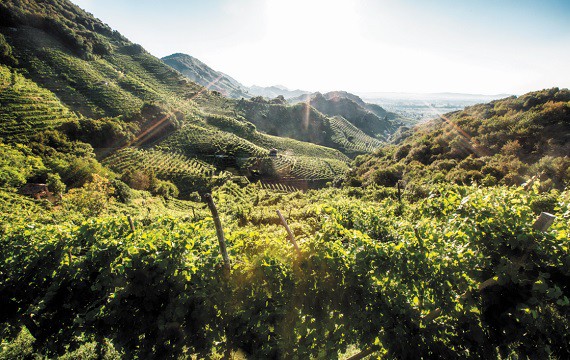Being the biggest landlord within the DOCG denomination, with 80ha, means Francesco Drusian can blend grapes from different terroirs to achieve a desired flavour profile without needing to add sugar.
“To have a naturally sweet, but dry prosecco the base wine must be good,” says Drusian. “I like to use grapes from a variety of vineyards because it makes our wine more consistent. We have a variety of vines between 40 and 100 years old, so we can blend different grapes together to get the required results regardless of the weather.”
SINGLE IS SWEET
Contrary to using as many vineyards as possible, Collalto is one of the biggest producers inside the DOCG area and in 2017 the winery launched a new project to focus on single vineyard production.
Collalto enologist Andrea Affili told DI that he believes the highest quality prosecco generally comes from single vineyards, but in response to this Francesco Drusian says: “I wouldn’t like to produce any prosecco using just one vineyard because if the weather is not as good as the previous year then it would be difficult to reproduce the same quality wine. This would then be difficult to communicate and it would be bad for international markets.”
Because it is dealing with just one area, Collalto should be able to control the natural sugar content in its wine because it is logistically more manageable to harvests grapes in one place, when the fruit is at its naturally sweet peak.
Affili adds: “In the future people will drink wines with less sugar and so we will be able to react to this demand when it comes.”
THE CAVE AGE
One other producer doing something different with its sugar levels is Valdo. The Valdobbiadene Prosecco Superior DOCG brand produces Valdo Numero 10, a classic-method brut which is re-fermented for 10 months in the bottle to preserve its sweet flavours. The classic method of prosecco production involves two fermentations, first in the bottle then, in this case, followed by six months’ ageing in a wine cave. This longer process often reduces the amount of additional sugar needed and the grapes involved are harvested in the third week of September when the fruit is at its optimal sweetness.
Valdo has a room dedicated to experimenting with barrel age finishing and a laboratory testing 30,000 samples a year. This search for new styles and flavour profiles will see the continued release of interesting, naturally sweet prosecco rolling out of this winery in the coming years.
There are certainly signs that DOCG prosecco is turning to wines with less sugar, but at the moment it only seems to be limited-edition and top-end varieties. Every individual wine addressed in this feature sits at the €25 price point, more than double a regular DOCG bottle.
Without doubt the category is still heavily in favour of dry and extra dry wines, but this evidence of fine wine-makers thinking less is more in terms of added sugar suggests we will see a change in attitude across the wider category in the coming years, which in the eyes of others will be more premium.




